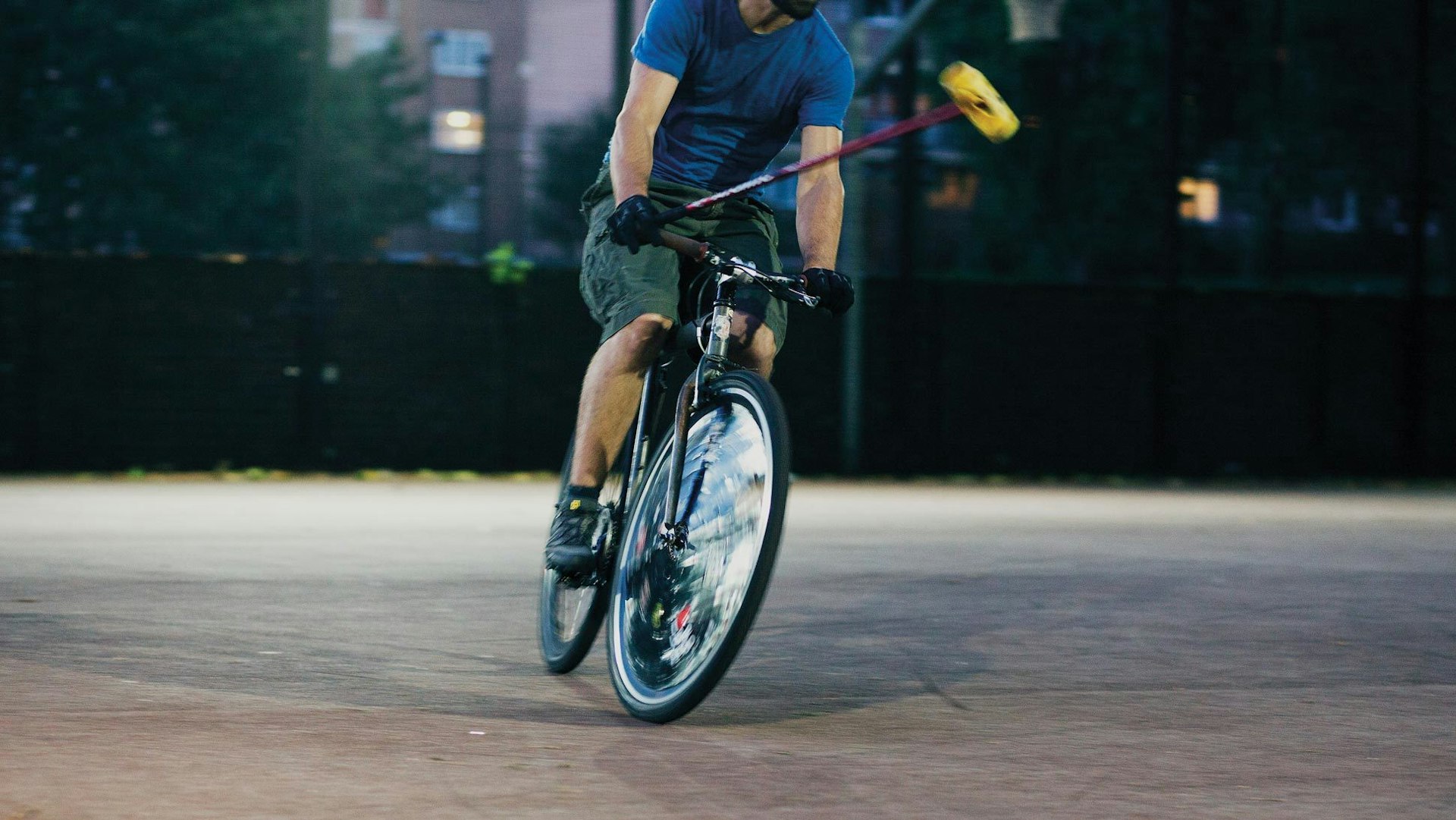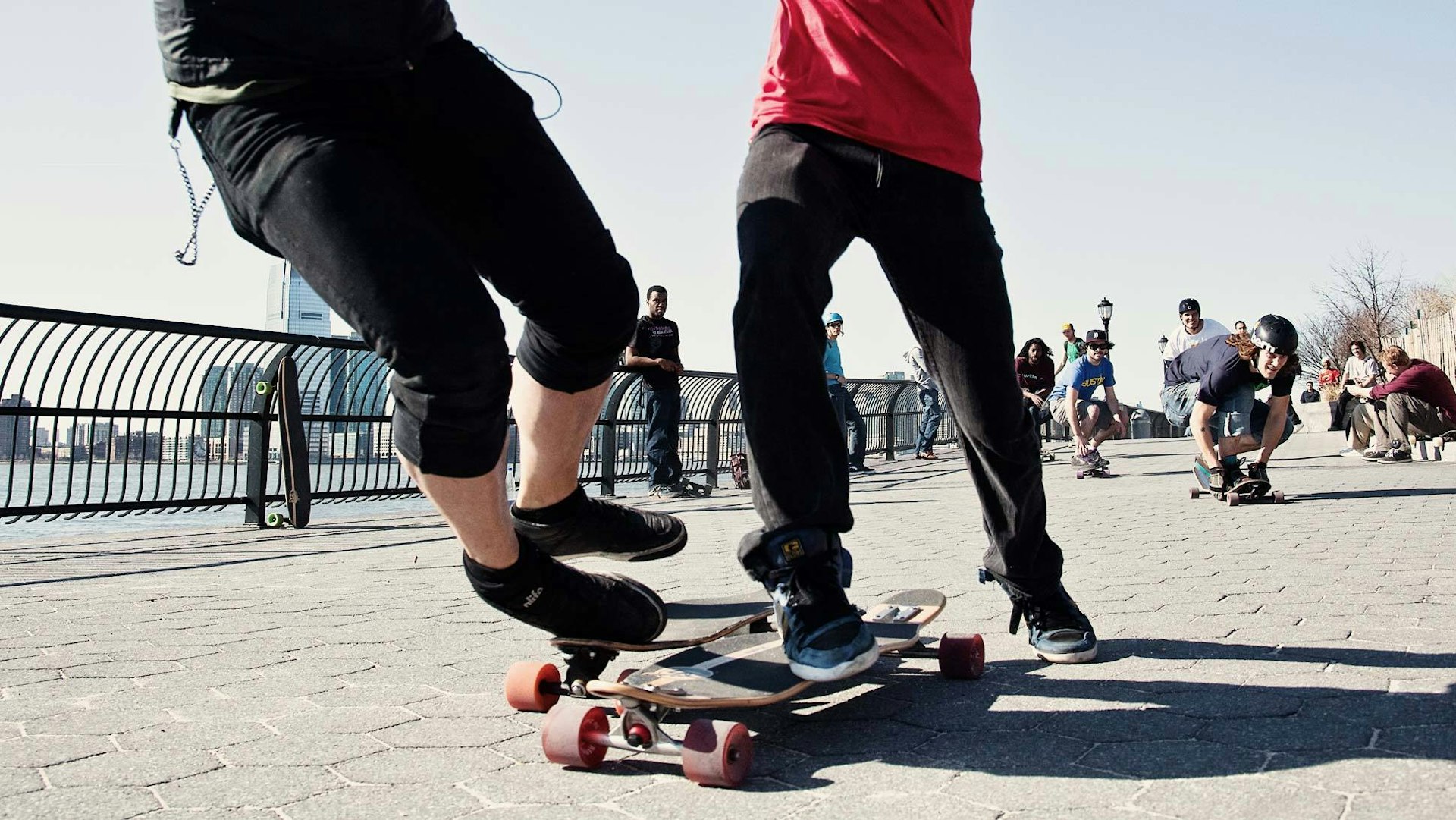
Bike Polo is flourishing on both sides of the Atlantic
- Text by Shannon Denny
- Photography by Paul Carver
Don’t let the name fool you. Hardcourt bike polo might call to mind a certain princely sport invented in Persia around 600BC – and later carried across the globe by colonial plantation owners, mustachioed cavalry officers and Argentine aristocrats – but if you show up at a practice expecting kitten-heeled spectators, a table of silver trophies and a tent serving Pimm’s and Pommery then you’re in for a shock.
It’s a weekday evening and a post-work crowd of urban bike-lovers are cracking open cans of Red Stripe around the perimeter of a tarmac playground where the inner-city London boroughs of Hackney and Islington meet. Here, among the council blocks and anti-climb paint, this underground sport is growing up like a bastard kid; pony polo may well be its mother, but reprobate youth culture is certainly the dad.
With its distinctively urban context, hardcourt polo shares common ground with hip hop, that Bronx-born movement that owes its existence to a confluence of deprivation, ingenuity and improvisation. Underfunded schools could offer turntables but not musical instruments, while the sides of subway trains stood in for artists’ canvasses. Out of this scarcity of resources came the underground expressions of scratching, graffiti, beatboxing and breakdancing, with early innovators literally making something out of nothing.
Bike polo may be less about economic deprivation, but the dearth of space and resources that goes hand-in-hand with urban life – and the brand of scrappy ingenuity that it engenders – is the same. And much like hip hop’s global growth, hardcourt bike polo is flourishing like some kind of tenacious weed that springs up in the cracks of an untended asphalt surface.
The roots of that weed, however, run deeper than you may think. An early precursor of hardcourt polo appeared at the end of the nineteenth century during the original bicycle craze, brought about by the handy invention of pneumatic tyres. An Irishman named Richard J. Mecredy (also spelled McCready) laid down rules for pursuing cycle polo on grass in 1891, and before the decade was out Americans and Europeans were playing competitively. Grass bike polo was a demonstration sport in the 1908 London Olympics and its popularity soared, until World War II largely halted its progress.
Fast-forward several decades, subtract the bucolic grassy setting and in its place insert a hefty dose of concrete, and the hardcourt revolution started to roll into the modern metropolis. Hardcourt polo got its start in 1999 in Seattle and by 2002 had spread to the bike-loving city of Portland. Two years later it popped up in New York, and by 2006 it had touched down in London.
According to the London Hardcourt Bike Polo Association (LHBPA), two years ago the sport had taken hold in about fifty metropolitan areas. Today you can find it in more than two-hundred-and-twenty cities, with an average of two new areas registering a bike polo scene every week. They estimate there are over 4,600 dedicated bike polo players worldwide with a further 20,000 who play infrequently.
So what’s the secret to its runaway success? As humanity tries desperately to wean itself off a destructive addiction to oil, two wheels have never held quite so much appeal. Cycle couriers are credited with the birth of hardcourt polo, and it’s not hard to see why. The skill-sets they’ve honed to navigate the urban environment (tight turns, stopping on a dime, standing still while poised on pedals and steering through miniscule gaps) are perfectly suited to this modern manifestation of the game.
Matt Bibby, who works as a designer for the streetwear label Chunk, remembers being instantly mesmerised upon first catching sight of bike polo three years ago: “I only came across the game because I was walking down the road with a couple of friends. We saw all these bikes gracefully gliding around in the sun chasing a ball.” Matt now plays at least once a week, while Chunk has made a habit of sponsoring both teams and tournaments.
In a world where technology, rules and hierarchy in sport are spiralling out of control, hardcourt polo is refreshingly straightforward. “We keep it simple,” says Matt. “Three people on a team, no foot-downs on the ground. If you do, the penalty is touching out at the sides in the middle.”
In league play, the first team to score five points wins the game with three games making up a match. In tournaments, games are timed to end at ten minutes. The only contact allowed is like-to-like, as in bike-to-bike or mallet-to-mallet. Referees officiate over tournament play, but regular meet-up games are self-policing.
“The biggest rule is, ‘Don’t be a dick,’” Matt says. “So if someone started throwing their weight around or getting out of line, everyone would just reel them in. And you don’t want to be that guy anyway; you don’t want to turn up in front of thirty or forty peers, friends and people you don’t even know and be the one everyone hates on.”
The infrastructure requirements are as minimal as the rulebook, although finding suitable courts in the centre of a crowded city can pose a significant challenge, says Dale Bickham, an Australian research scientist who’s played since the early days of the British hardcourt scene: “People are particular about what the court plays like. In London there are space restrictions and a lot of people playing football on similar courts, so there’s a bit of a clash.” An ideal court will have one entry point, no gaps in the fence where a ball can escape, a smooth surface without a slope, unbroken pavement and floodlights to facilitate wintertime play. Diehard fans have been known to scour Google Earth in search of grey rectangles with a row of lights down the side.
“People have sought different locations,” Dale says, pointing to examples of a recent tournament in Manchester played on an indoor ice hockey rink and another hosted inside Spitalfields Market in London. “But it’s always come back to three or four staple courts that get used over and over.”
The LHBPA is working toward standardising court requirements to enable consistency, and has also established equipment rules to promote safety. For example, bar ends have to be smooth and plugged “so if you fall on them you don’t get sort of apple-cored, which is a pretty nasty experience,” Dale explains. “The more serious it gets, people don’t want to give up the ball so they just keep on going, and that’s when you get more injuries.” There have been skull fractures, broken collarbones and split knuckles, so some players opt for protective gear borrowed from other sports, like cricket helmets and hockey gloves. These provide protection from swinging mallets, flying balls – and the ground.
But with the sport still in its infancy, you won’t find a bike polo section in Foot Locker or Lillywhite’s just yet. As a result, borrowing and hacking are intrinsic features of the scene. Bikes are often cobbled together from spare parts, and Felix Cramer, a college student, illustrates how DIY skills have come in handy in fashioning his much-used mallet. “It’s a golf club and electrical tape,” he tells me. “I played with it so much I broke the end off it, so there was a massive hole. So what you do is put a penny on it or a cork and tape over it.”
Ski poles or bamboo are other common components used to serve as mallet shafts, while mallet heads are typically made from plastic piping requisitioned from building sites or roadworks. “People find them, happily,” Felix divulges. “The official rules say twelve centimetres is the longest you can have. Drill holes take the weight out, or people will have one massive hole so they can scoop the ball with the side of the mallet.”
Wheel covers are another modification that calls upon a player’s upcycling savvy. These prevent damage to spokes, and also provide a tactical advantage. “They’re quite handy,” Felix says. “If you’ve got the ball on one side of you and the attacking or opposing player is on the other side of you, they can’t see the ball through the wheel.” In London, the ubiquitous estate agent signs provide the perfect corrugated plastic medium for the job. One player’s wheels sport the unmistakable livery of one of the country’s most notoriously greedy agencies; “I’m sponsored by Foxtons,” he grins.
With more players catching polo fever every day of the week, tournament play is on the rise. In 2010, thirty-one teams competed for the UK Championship in April, while forty-eight teams took part in August’s European Championships in Geneva. That same month, the World Hardcourt Polo Championships in Berlin saw sixty-four teams battling over the course of three days, and then less than a week later teams from ten countries fought it out in LHBPA’s London Open where a Seattle team won the top prize; a quiver of polo bicycles custom-made by London’s 14 Bike Co.
Back at the Red Stripe-fuelled meet-up, though, the absence of a winners’ podium hasn’t diminished the compulsion to play. But first, cones must be found to serve as goal markers. When I ask where they’ll get cones at this time of night, one two-wheeled bandit grins, “They’re donated by the local council!” Within minutes the pack returns with the desired contraband in hand, and he announces, “Philanthropy – modern philanthropy in action, that’s what it is.”
Resembling a tribe of urban Robin Hoods, the merry band gets down to business. Somewhere far away on a green expanse of real estate, bike polo’s pony-based predecessor is no doubt carrying on its traditions among pricey horseflesh, full-time grooms and magnums of Champagne. Here, however, the satisfying sound of ball against plastic is followed by a ‘ping’ as the projectile finds a chain-link fence. There are high-speed chases and instant emergency stops, crashing, weaving, scraping and scrapping as the quarry wiggles free. Occasionally the ball becomes airborne before being tamed again by the pack of hungry cyclists, circling like piranhas in a rough sea of grey tower blocks and crumbling concrete. They sail around smoothly before one casually, but decisively, puts the little orb between the traffic cones.
